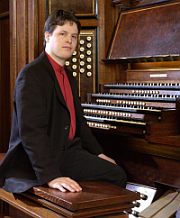
Tortelier opened with a suite of five movements from Bizet’s incidental music to L’Arlésienne, plus Poulenc’s Organ Concerto in G Minor with Paul Jacobs as soloist. After intermission, violinist Nadya Tichman (the Symphony’s associate concertmaster) was featured in Vaughan Williams’ lyrical romance The Lark Ascending (1920) for violin and reduced orchestra, before that composer’s blockbuster Symphony No. 4 in F Minor (1934). The concert also included a small gesture toward America’s most frequently performed operatic composer. (More on that anon.)
The Vaughan Williams Fourth, easily one of the last century’s greatest symphonies, broke completely with the expected. Like those of his much-admired Sibelius, Vaughan Williams’ first three symphonies were mildly patriotic pieces in traditional harmonies and textures. But for their fourth symphonies, each lcomposer urched into a starkly violent 20th-century style of raw dissonances and unparalleled experiments in texture.
Listeners have to bear in mind that Vaughan Williams had served on the battlefields of France during World War I. He knew what carnage felt like. And by the early 1930s, anyone with even a glimmer of insight could tell that trouble was brewing on the continent, in Germany, Italy, Spain, and Russia.
Although he always denied it, the Fourth is his antiwar, anti-Nazi work. It is based on the name of the great German composer Bach. It uses a common musical cipher for the name of Johann Sebastian Bach (B-flat/A/C/B-natural in German notation). The layout of the movements also owes much to Beethoven’s Fifth Symphony. As the program book mentioned, the VW Fourth has been compared to “... a nightmare version of Beethoven’s Fifth.”
As if to emphasize the Germanic connection, Vaughan Williams littered his symphony with fugues and double fugues, occasionally piled up on one another at such short distances that they seem to be stepping all over each other’s feet. Then too, the slow movement is a free passacaglia in funeral-march style. Rarely in his scores will you find such thickness.
He was outraged by this common analysis of his composition, as indeed he was by the fact that his other superdissonant symphony, the Sixth, was a portrait of the London Blitz. But it’s all there, including a third movement in the Sixth memorializing a British jazz musician killed in the bombing raids. It includes a distorted quotation of that musician’s greatest hit recording.
Those two symphonies, the Fourth and the Sixth of Vaughan Williams, are as emotionally powerfully as any of Mahler’s, especially when played as well as what Tortelier drew from the S.F. Symphony on Friday evening. I’ve not heard an interpretation of the Fourth as close to Vaughan Williams’ own recording of it with the BBC Symphony — a recording I owned as a teen. Considering how frantic the music is, I was a little startled to witness the standing ovation that epilogued the performance. After all, it’s not exactly easy listening.
By extreme contrast, The Lark Ascending is almost painfully beautiful. It really is a little tone poem inspired by George Meredith’s tender lyric. The violinist uses all sorts of birdlike figurations and arabesques to embellish a haunting theme in English modal style. Tichman’s playing was simply ravishing in its beauty of timbre and superb musicality. She also rated her standing ovation. She was magical.
Soloist vs. Conductor

Photo by Stefan Cohen
Tortelier compiled his own Bizet Suite, using three movements from the first L’Arlésienne Suite, reorchestrated by the composer himself in 1872 from the original chamber orchestra version. Those movements included the Carillone, Menuet, and Adagietto.
The Suite opened and closed with two pieces from Suite No. 2, the Pastorale and the famous Farandole. That second Suite was orchestrated in 1876 by the American composer Ernest Guiraud, a distinguished faculty member of the Paris Conservatory (where Debussy was one of his students).
What, never heard of Guiraud? But you have heard his music, and often. Born in New Orleans, he wrote his first opera there at age 15, calling it Le Roi David. He was then off for advanced training in Paris, where he made a brilliant career after winning the Prix de Rome. Returning to Paris he was appointed to the Conservatory staff, and remained there until his death in 1892, producing a string of quite successful operas, especially Piccolino.
Known for his solid technique, especially in orchestration, it was Guiraud who created all the recitatives for Bizet’s Carmen, setting the original spoken dialogue to music. He also completed and orchestrated Offenbach’s Tales of Hoffman. In turn, the esteem that fellow composers held him in was such that after he died, Saint-Saëns completed Guiraud’s final unfinished opera, Frédégonde. His 1892 treatise on orchestration became what composers such as Dukas, Ravel, and Milhaud used to polish their craft. In fact, Guiraud was called “the new Berlioz” of his time.
What a shame he’s so forgotten. But you could definitely hear his brilliance in those two L’Arlésienne excerpts — as indeed you do every time you hear Carmen or Tales of Hoffmann.

